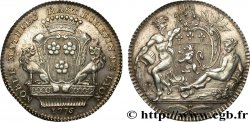E-auction 135-75810 - fjt_361189 - LYONNAIS - CONSULATE OF LYON Hugues Riverieulx de Varax, seconde prévôté 1749
You must signin and be an approved bidder to bid, LOGIN TO BID. Accounts are subject to approval and the approval process takes place within 48 hours. Do not wait until the day a sale closes to register. Clicking on « bid » constitutes acceptance of the terms of use of cgb.fr private e-auctions.
Bids must be placed in whole Euro amounts only. The sale will start closing at the time stated on the item description; any bids received at the site after the closing time will not be executed. Transmission times may vary and bids could be rejected if you wait until the last second. For further information ckeck the E-auctions F.A.Q.
NO BUYER'S FEE.
NO BUYER'S FEE.
| Estimate : | 150 € |
| Price : | 107 € |
| Maximum bid : | 127 € |
| End of the sale : | 16 November 2015 19:16:00 |
| bidders : | 8 bidders |
Type : Hugues Riverieulx de Varax, seconde prévôté
Date: 1749
Metal : silver
Diameter : 30 mm
Orientation dies : 6 h.
Weight : 10,21 g.
Edge : striée
Rarity : R1
Coments on the condition:
jolie patine au revers
Catalogue references :
Obverse
Obverse legend : * DE. LA. 2E. PREVOTE. DE. MRE. HUGUES. RIVERIEULX. DE. VARAX. 1749.
Obverse description : Écu en forme de poire aux armes d’Hugues Riverieulx, portant d’azur à une rivière d’argent surmonté d’un croissant du même, placé sur un cartouche et supporté par deux aigles, sommé d’une couronne comtale, au-dessous 17 - 49.
Reverse
Reverse legend : * MRS. DE LA CHAPELLE. BOURBON. RICHERI. FLACHAT. EC. D. LYON.
Reverse description : Écussons aux armes des quatre échevins, posés deux et deux et accompagnés de cimiers et lambrequins, au-dessous 1749.








 Report a mistake
Report a mistake Print the page
Print the page Share my selection
Share my selection Ask a question
Ask a question Consign / sell
Consign / sell
 Full data
Full data















